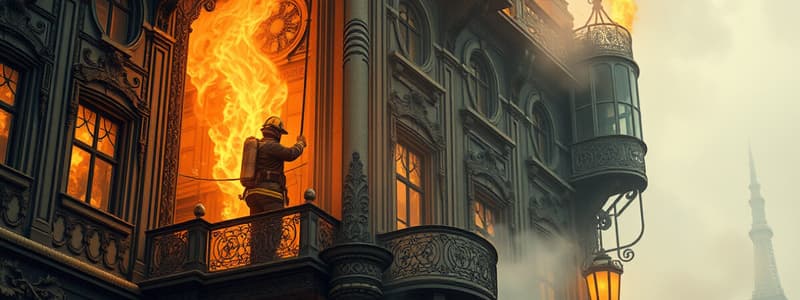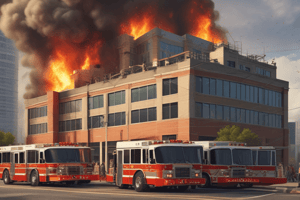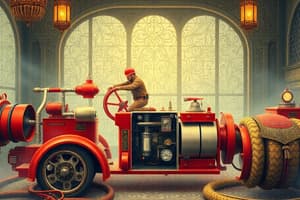Podcast
Questions and Answers
What is the primary purpose of pressurizing stairwells in high rise fires?
What is the primary purpose of pressurizing stairwells in high rise fires?
- To facilitate the use of elevators
- To make stairwells more accessible for evacuees
- To ensure adequate lighting in stairwells
- To create a higher pressure area limiting smoke migration (correct)
Which strategy is not recommended for smoke removal in high rise fires?
Which strategy is not recommended for smoke removal in high rise fires?
- Designating a ventilation stairwell
- Ventilating smoke as a primary option (correct)
- Utilizing electric fans for smoke control
- Using stairwells as evacuation routes
What should firefighters do when the location of the fire is unknown?
What should firefighters do when the location of the fire is unknown?
- Search only the top floors first
- Set up a command post on the roof
- Use elevators to check for fire
- Begin from entry level and check upwards (correct)
What is a critical action to take before using a designated ventilation stairwell?
What is a critical action to take before using a designated ventilation stairwell?
Which of the following describes wind driven fire conditions?
Which of the following describes wind driven fire conditions?
In the context of high rise fire operations, what does 'continuous vertical openings' refer to?
In the context of high rise fire operations, what does 'continuous vertical openings' refer to?
What is advised against when dealing with known wind driven fires?
What is advised against when dealing with known wind driven fires?
Which truck company action is essential for proper stairwell operations?
Which truck company action is essential for proper stairwell operations?
What should be done to maintain the integrity of the attack stairwell before engaging in a fire attack?
What should be done to maintain the integrity of the attack stairwell before engaging in a fire attack?
Before opening a door during a fire attack, what is crucial regarding SCBA?
Before opening a door during a fire attack, what is crucial regarding SCBA?
What should be done if a wind-driven fire is evident during an attack?
What should be done if a wind-driven fire is evident during an attack?
What is the first step regarding the corridor before conducting any operations?
What is the first step regarding the corridor before conducting any operations?
Under what condition should elevators not be used during a fire incident?
Under what condition should elevators not be used during a fire incident?
What should a firefighter check before entering an elevator during a fire?
What should a firefighter check before entering an elevator during a fire?
What is the minimum length of a charged hose line that should be brought to the scene?
What is the minimum length of a charged hose line that should be brought to the scene?
What is a key responsibility of lobby control during an incident?
What is a key responsibility of lobby control during an incident?
What must be ensured when preparing to use an elevator during a fire incident?
What must be ensured when preparing to use an elevator during a fire incident?
Which action is critical after identifying wind driven fire conditions during an attack?
Which action is critical after identifying wind driven fire conditions during an attack?
What is the primary role of the 3rd Due Truck in a high-rise fire scenario?
What is the primary role of the 3rd Due Truck in a high-rise fire scenario?
What should firefighters do with the keys after using the elevator in an emergency?
What should firefighters do with the keys after using the elevator in an emergency?
During initial attack preparations, what condition must be true regarding the corridor?
During initial attack preparations, what condition must be true regarding the corridor?
What is a primary characteristic of high rise buildings in relation to firefighting operations?
What is a primary characteristic of high rise buildings in relation to firefighting operations?
Which method is emphasized for managing smoke in high rise fires?
Which method is emphasized for managing smoke in high rise fires?
During a wind-driven fire, what effect is typically observed?
During a wind-driven fire, what effect is typically observed?
What is a critical step to take regarding stairwell operations before using them?
What is a critical step to take regarding stairwell operations before using them?
Which operation is specifically forbidden during wind-driven fires to ensure safety?
Which operation is specifically forbidden during wind-driven fires to ensure safety?
What is a potential consequence of having many open doors during a high rise fire?
What is a potential consequence of having many open doors during a high rise fire?
When managing smoke in a high rise building, which statement is accurate regarding the use of fans?
When managing smoke in a high rise building, which statement is accurate regarding the use of fans?
What is a critical action for the 3rd Due Truck when responding to a high rise fire?
What is a critical action for the 3rd Due Truck when responding to a high rise fire?
Which operational guideline must be followed when smoke conditions indicate a wind-driven fire?
Which operational guideline must be followed when smoke conditions indicate a wind-driven fire?
During fire incident operations, what aspect of continuous vertical openings is paramount?
During fire incident operations, what aspect of continuous vertical openings is paramount?
Flashcards are hidden until you start studying
Study Notes
High Rise Fire Operations
- High rise buildings defined as those over 5 stories or 75 feet above the lowest fire department vehicle access.
- Fire suppression is complicated due to rapid smoke spread and challenges with occupant safety.
- Positive pressure fans are employed in stairwells to prevent smoke migration into occupied compartments.
Smoke Control Strategies
- Stairwells act as refuges and are crucial in controlling smoke and toxic gases.
- Initiate smoke control by pressurizing stairwells, as not all doorways can be effectively managed.
- The first truck is responsible for placing fans at the base of the attack stairwell, while electric fans are preferred.
- Fans should be positioned 2 floors below and at the base for buildings above the 9th floor.
- The third truck will ensure all stairwells are pressurized and manage ventilation strategies.
Search Operations
- Conduct vertical searches from entry level upwards without the use of elevators.
- The third due engine should check continuous vertical openings like trash chutes or elevator shafts to locate the fire.
Wind-Driven Fire Considerations
- A wind-driven fire can cause dynamic smoke and flame movement.
- Signs include smoke pushing around doors and high pressure against doors when opening.
- Never open doors in known wind-driven fire scenarios without command notification.
Stairwell Operations and Safety
- Maintain integrity of the attack stairwell; pressurize before engagement.
- Use self-contained breathing apparatus (SCBA) with the regulator ready before door entry.
- Look for signs of wind-driven fires; if evident, halt the attack and communicate with command.
Stairwell Designation
- The first due engine designates the attack stairwell; the third due truck checks the ventilation stairwell.
Elevator Use Protocols
- Elevators should not be utilized if smoke, heat, or fire is detected in the elevator shaft.
- Ensure firemen’s service is operational and avoid using elevators for incidents below the fifth floor.
- Conduct checks for smoke or fire in the hoist way before entering the elevator.
- Maintain safety equipment like PPE and SCBA at the ready while using elevators.
Attack Line Procedures
- In the presence of smoke or fire, advance a charged hose line with a minimum length of 200 feet.
- The second engine should assist the first engine in stretching and preparing to extend the line.
Lobby Control Operations
- A Central Control Officer (CCO) may be designated to manage the lobby area.
- Conduct a needs assessment to provide additional information to the Incident Commander (IC) while controlling elevator access.
High Rise Fire Operations
- High rise buildings defined as those over 5 stories or 75 feet above the lowest fire department vehicle access.
- Fire suppression is complicated due to rapid smoke spread and challenges with occupant safety.
- Positive pressure fans are employed in stairwells to prevent smoke migration into occupied compartments.
Smoke Control Strategies
- Stairwells act as refuges and are crucial in controlling smoke and toxic gases.
- Initiate smoke control by pressurizing stairwells, as not all doorways can be effectively managed.
- The first truck is responsible for placing fans at the base of the attack stairwell, while electric fans are preferred.
- Fans should be positioned 2 floors below and at the base for buildings above the 9th floor.
- The third truck will ensure all stairwells are pressurized and manage ventilation strategies.
Search Operations
- Conduct vertical searches from entry level upwards without the use of elevators.
- The third due engine should check continuous vertical openings like trash chutes or elevator shafts to locate the fire.
Wind-Driven Fire Considerations
- A wind-driven fire can cause dynamic smoke and flame movement.
- Signs include smoke pushing around doors and high pressure against doors when opening.
- Never open doors in known wind-driven fire scenarios without command notification.
Stairwell Operations and Safety
- Maintain integrity of the attack stairwell; pressurize before engagement.
- Use self-contained breathing apparatus (SCBA) with the regulator ready before door entry.
- Look for signs of wind-driven fires; if evident, halt the attack and communicate with command.
Stairwell Designation
- The first due engine designates the attack stairwell; the third due truck checks the ventilation stairwell.
Elevator Use Protocols
- Elevators should not be utilized if smoke, heat, or fire is detected in the elevator shaft.
- Ensure firemen’s service is operational and avoid using elevators for incidents below the fifth floor.
- Conduct checks for smoke or fire in the hoist way before entering the elevator.
- Maintain safety equipment like PPE and SCBA at the ready while using elevators.
Attack Line Procedures
- In the presence of smoke or fire, advance a charged hose line with a minimum length of 200 feet.
- The second engine should assist the first engine in stretching and preparing to extend the line.
Lobby Control Operations
- A Central Control Officer (CCO) may be designated to manage the lobby area.
- Conduct a needs assessment to provide additional information to the Incident Commander (IC) while controlling elevator access.
High Rise Fire Operations
- High rise buildings defined as those over 5 stories or 75 feet above the lowest fire department vehicle access.
- Fire suppression is complicated due to rapid smoke spread and challenges with occupant safety.
- Positive pressure fans are employed in stairwells to prevent smoke migration into occupied compartments.
Smoke Control Strategies
- Stairwells act as refuges and are crucial in controlling smoke and toxic gases.
- Initiate smoke control by pressurizing stairwells, as not all doorways can be effectively managed.
- The first truck is responsible for placing fans at the base of the attack stairwell, while electric fans are preferred.
- Fans should be positioned 2 floors below and at the base for buildings above the 9th floor.
- The third truck will ensure all stairwells are pressurized and manage ventilation strategies.
Search Operations
- Conduct vertical searches from entry level upwards without the use of elevators.
- The third due engine should check continuous vertical openings like trash chutes or elevator shafts to locate the fire.
Wind-Driven Fire Considerations
- A wind-driven fire can cause dynamic smoke and flame movement.
- Signs include smoke pushing around doors and high pressure against doors when opening.
- Never open doors in known wind-driven fire scenarios without command notification.
Stairwell Operations and Safety
- Maintain integrity of the attack stairwell; pressurize before engagement.
- Use self-contained breathing apparatus (SCBA) with the regulator ready before door entry.
- Look for signs of wind-driven fires; if evident, halt the attack and communicate with command.
Stairwell Designation
- The first due engine designates the attack stairwell; the third due truck checks the ventilation stairwell.
Elevator Use Protocols
- Elevators should not be utilized if smoke, heat, or fire is detected in the elevator shaft.
- Ensure firemen’s service is operational and avoid using elevators for incidents below the fifth floor.
- Conduct checks for smoke or fire in the hoist way before entering the elevator.
- Maintain safety equipment like PPE and SCBA at the ready while using elevators.
Attack Line Procedures
- In the presence of smoke or fire, advance a charged hose line with a minimum length of 200 feet.
- The second engine should assist the first engine in stretching and preparing to extend the line.
Lobby Control Operations
- A Central Control Officer (CCO) may be designated to manage the lobby area.
- Conduct a needs assessment to provide additional information to the Incident Commander (IC) while controlling elevator access.
Studying That Suits You
Use AI to generate personalized quizzes and flashcards to suit your learning preferences.




